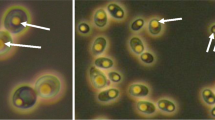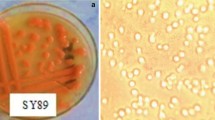Abstract
In this study, nine heterotrophic yeast isolates were tested for their ability to assimilate crude glycerol and consecutive conversion to triacylglycerides (TGAs). All the organisms were initially screened on crude glycerol-based selection media, and those producing lipid globules were further evaluated for lipid production. Sudan Black B staining of eight isolates showed lipid globules. These strains were further studied at different C/N ratio. The molecular identification revealed that the isolates belonged to the genera of Yarrowia and Candida. Among these isolates, SKY7 (Yarrowia lipolytica) produced up to 42.04 ± 0.11 % of lipid w/w) with a C/N ratio of 100 and fermentation time of 72 h. The other strains produced 5.82 ± 0.4 to 34.57 ± 0.44 % lipid (w/w). The GC-flame ionization detector (FID) lipid profile showed that the lipid produced by the strains had close resemblance with vegetable oil and could serve as a feedstock for biodiesel production. Biolog test of the isolates revealed a wide spectrum of carbon utilization.



Similar content being viewed by others
References
Almeida, J. R., Favaro, L. C., & Quirino, B. F. (2012). Biotechnology for Biofuels, 5, 48.
Papanikolaou, S., & Aggelis, G. (2002). Bioresource Technology, 82, 43–49.
Mu, Y., Xiu, Z.-L., & Zhang, D.-J. (2008). Biochemical Engineering Journal, 40, 537–541.
Huijberts, G. N. M., & Eggink, G. (1996). Applied Microbiology and Biotechnology, 45, 575–579.
Mantzouridou, F., Naziri, E., & Tsimidou, M. Z. (2008). Journal of Agricultural and Food Chemistry, 56, 2668–2675.
Mothes, G., Schnorpfeil, C., & Ackermann, J. U. (2007). Engineering in Life Sciences, 7, 475–479.
Papanikolaou, S., & Aggelis, G. (2009). Lipid Technology, 21, 83–87.
Lin, Y.-H., Luo, J.-J., John Hwang, S.-C., Liau, P.-R., Lu, W.-J., & Lee, H.-T. (2011). Biomass and Bioenergy, 35, 2217–2223.
Gwendoline Christophe, V. K., Nouaille, R., Gaudet, G., Pierre, A. P., Fontanille, A. P., Soccol, C. R., & Larroche, C. (2012). Brazilian Archives of Biology and Technology, 55, 29–46.
Azocar, L., Ciudad, G., Heipieper, H. J., & Navia, R. (2010). Applied Microbiology and Biotechnology, 88, 621–636.
Ageitos, J. M., Vallejo, J. A., Veiga-Crespo, P., & Villa, T. G. (2011). Applied Microbiology and Biotechnology, 90, 1219–1227.
Kitcha, S., & Cheirsilp, B. (2011). Energy Procedia, 9, 274–282.
Kornelia Smalla, U. W., Heuer, H., Liu, W.-T., & Forney, L. (1998). Applied and Environmental Microbiology, 64, 1220–1225.
Zhou, J., Bruns, M. A., & Tiedje, J. M. (1996). Applied and Environmental Microbiology, 62, 316–322.
Sequerra, J., Marmeisse, R., Valla, G., Normand, P., Capellano, A., & Moiroud, A. (1997). Mycological Research, 101, 465–472.
Browse, J., McCourt, P. J., & Somerville, C. R. (1986). Analytical Biochemistry, 152, 141–145.
Bondioli, P., & Della Bella, L. (2005). European Journal of Lipid Science and Technology, 107, 153–157.
Garland, J. L., & Mills, A. L. (1991). Applied and Environmental Microbiology, 57, 2351–2359.
Rehm, H. J., & Ratledge, G. R. C. (2008). Microbial lipids. Biotechnology: products of 16 secondary. Metabolism, 7, 135–142.
Taccari, M., Canonico, L., Comitini, F., Mannazzu, I., & Ciani, M. (2012). Bioresource Technology, 110, 488–495.
Chatzifragkou, A., & Papanikolaou, S. (2012). Applied Microbiology and Biotechnology, 95, 13–27.
Makri, A., Fakas, S., & Aggelis, G. (2010). Bioresource Technology, 101, 2351–2358.
Beopoulos, A., Cescut, J., Haddouche, R., Uribelarrea, J. L., Molina-Jouve, C., & Nicaud, J. M. (2009). Yarrowia lipolytica as Progress in Lipid Research, 48, 375–387.
Jacob, Z., & Krishnamurthy, M. (1990). Journal of the American Oil Chemists, 67, 642–645.
Acknowledgments
Authors would like to acknowledge the Natural Sciences and Engineering Research Council of Canada (grant A4984, strategic grant 412994-11, Canada Research Chairs) for financial support. We are grateful to technical staffs of INRS-ETE, for their timely help to analyze the samples on GC-FID.
Author information
Authors and Affiliations
Corresponding author
Rights and permissions
About this article
Cite this article
Kuttiraja, M., Krishna, S., Dhouha, A. et al. A Substrate-Based Approach for the Selection of Oil-Bearing Heterotrophs from Nitrogen-Deficient Soil for Lipid Production. Appl Biochem Biotechnol 175, 1926–1937 (2015). https://doi.org/10.1007/s12010-014-1378-0
Received:
Accepted:
Published:
Issue Date:
DOI: https://doi.org/10.1007/s12010-014-1378-0




